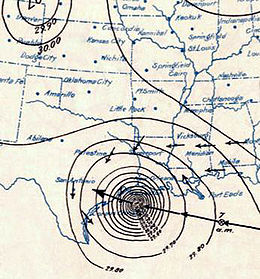Galveston Hurricane
| Category 4 major hurricane (SSHWS/NWS) | |

Surface weather analysis of the hurricane on September 8, just before landfall.
|
|
| Formed | August 27, 1900 |
|---|---|
| Dissipated | September 17, 1900 |
| (Extratropical after September 11, 1900) | |
| Highest winds |
1-minute sustained: 145 mph (230 km/h) |
| Lowest pressure | 936 mbar (hPa); 27.64 inHg |
| Fatalities | 6,000–12,000 direct |
| Damage | $21 million (1900 USD) (equivalent to $605 million in 2016, adjusted for inflation; see §Aftermath for more) |
| Areas affected | Lesser Antilles, Puerto Rico, Hispaniola, Jamaica, Cuba, Turks and Caicos Islands, Bahamas, Florida, Mississippi, Louisiana, Texas, Oklahoma, Kansas, Nebraska, Iowa, Illinois, Wisconsin, Michigan, New York, Eastern Canada |
| Part of the 1900 Atlantic hurricane season | |
The Great Galveston Hurricane was a Category 4 storm, with winds of up to 145 mph (233 km/h), which made landfall on September 8, 1900, in Galveston, Texas, in the United States, leaving about 6,000 to 12,000 dead. It remains to the present day the deadliest single day event in US history.
The hurricane appears to have started as an atmospheric trough from West Africa, causing unsettled weather in the Caribbean, and emerging into the Florida Straits as a tropical storm on September 5. Owing to contradictory forecasts, the people of Galveston felt no alarm until the official hurricane warning of September 7. Next morning a storm surge of 15 ft (4.6 m) washed over the long, flat island-city which was only 8 ft (2.4 m) above sea level, knocking buildings off their foundations and destroying over 3,600 homes.
The disaster ended the Golden Era of Galveston, as the hurricane alarmed potential investors, who turned to Houston instead. The whole island of Galveston was presently raised by 17 ft (5.2 m) and a 10 sq mi (26 km2) seawall erected.
The Hurricane of 1900, also known as the Great Galveston Hurricane, made landfall on September 8, 1900, in Galveston, Texas, in the United States. It had estimated winds of 145 miles per hour (233 km/h) at landfall, making it a Category 4 storm on the Saffir–Simpson Hurricane Scale. It was the deadliest hurricane in US history, and the second costliest hurricane in U.S. history based on the dollar's 2005 value (to compare costs with those of Hurricane Katrina and others).
The hurricane caused great loss of life with a death toll of between 6,000 and 12,000 people; the number most cited in official reports is 8,000, giving the storm the third-highest number of deaths or injuries of any Atlantic hurricane, after the Great Hurricane of 1780 and 1998's Hurricane Mitch. The Galveston Hurricane of 1900 is the deadliest natural disaster ever to strike the United States. The second-deadliest storm to strike the United States, the 1928 Okeechobee hurricane, caused more than 2,500 deaths, and the deadliest storm of recent times, Hurricane Katrina, claimed the lives of approximately 1,800 people.
...
Wikipedia
